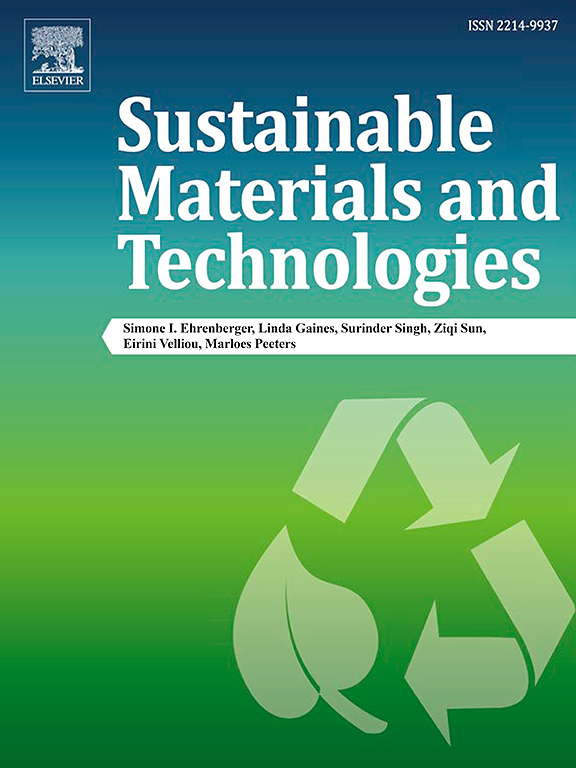硫代硫酸钠修饰的氮化石墨用于提高光催化生产醛类的能力
IF 8.6
2区 工程技术
Q1 ENERGY & FUELS
引用次数: 0
摘要
醇氧化成醛是有机化学中最重要的反应之一。目前使用的方法以昂贵的贵金属催化剂、有毒溶剂以及高温高压条件为基础,因此人们开始寻求更柔和、更便宜的替代方法,如光催化法。从这个意义上说,氮化石墨以硫代硫酸钠作为 S 和 Na+ 的加入源对其结构进行了改性,旨在提高其在水溶液中将醇氧化成醛(即肉桂醛、苯甲醛和香兰素)的光催化性能。用硫代硫酸钠处理由不同前体(即三聚氰胺、硫脲和尿素)合成的三种 g-C3N4 样品。尿素产生的 g-C3N4 具有最高的介孔率(表面积,69 m2 g-1)和光催化活性。用 5 %(重量)的 Na2S2O3 改性后,肉桂醇氧化的假一阶速率常数从 0.265 h-1(裸样品)提高到 0.792 h-1(Na2S2O3 改性样品)。该材料的特性表明,在结构中加入 S 和 Na+ 后,光生电荷的电荷分离效果更好,从而最大限度地降低了光生电荷的重组率。在水溶液中测试的最佳光催化剂在生产苯甲醛(选择性为 100%)、肉桂醛(23%)和香兰素(5%)时选择性最高。在乙腈作为溶剂介质的情况下,选择性大大提高,肉桂醛的选择性从水中的 23% 提高到纯乙腈中的 51%。降解机理表明,光生空穴和超氧自由基的影响很大,后者对酒精的氧化选择性更大。本文章由计算机程序翻译,如有差异,请以英文原文为准。
Sodium thiosulfate modified graphitic carbon nitride for enhancing the photocatalytic production of aldehydes
The oxidation of alcohols to aldehydes is one of the most relevant reactions in organic chemistry. The currently implemented methods based on expensive noble metallic catalysts, toxic solvents, and high temperature and pressure conditions have released the seek for softer and cheaper alternatives such as photocatalysis. In this sense, graphitic carbon nitride has been modified with sodium thiosulfate as a source of S and Na+ incorporation in the structure, aimed at enhancing the photocatalytic performance on the oxidation of alcohols to aldehydes, i.e. cinnamaldehyde, benzaldehyde, and vanillin in aqueous solution. Three g-C3N4 samples synthesized from different precursors, i.e. melamine, thiourea, and urea, were treated with sodium thiosulfate. Urea led to the g-C3N4 with the highest mesoporosity (surface area, 69 m2 g−1) and photocatalytic activity. The modification with 5 % (wt.) of Na2S2O3 enhanced the pseudo-first order rate constant of cinnamyl alcohol oxidation from 0.265 h−1 (bare sample) to 0.792 h−1 (Na2S2O3-modified). The characterization of the material suggests a better charge separation of the photogenerated charges after S and Na+ incorporation in the structure, minimizing the recombination rate of photogenerated charges. The optimum photocatalyst, tested in aqueous solution, was most selective in the production of benzaldehyde (selectivity, >100 %) > cinnamaldehyde (>23 %) > vanillin (∼5 %). The selectivity was considerably boosted under acetonitrile as the solvent medium, raising in the case of cinnamaldehyde the 23 % recorded in water to 51 % in pure acetonitrile. The degradation mechanism suggests a strong influence of the photogenerated holes and the superoxide radical, the latter being more selective in the oxidation of the alcohol.
求助全文
通过发布文献求助,成功后即可免费获取论文全文。
去求助
来源期刊

Sustainable Materials and Technologies
Energy-Renewable Energy, Sustainability and the Environment
CiteScore
13.40
自引率
4.20%
发文量
158
审稿时长
45 days
期刊介绍:
Sustainable Materials and Technologies (SM&T), an international, cross-disciplinary, fully open access journal published by Elsevier, focuses on original full-length research articles and reviews. It covers applied or fundamental science of nano-, micro-, meso-, and macro-scale aspects of materials and technologies for sustainable development. SM&T gives special attention to contributions that bridge the knowledge gap between materials and system designs.
 求助内容:
求助内容: 应助结果提醒方式:
应助结果提醒方式:


